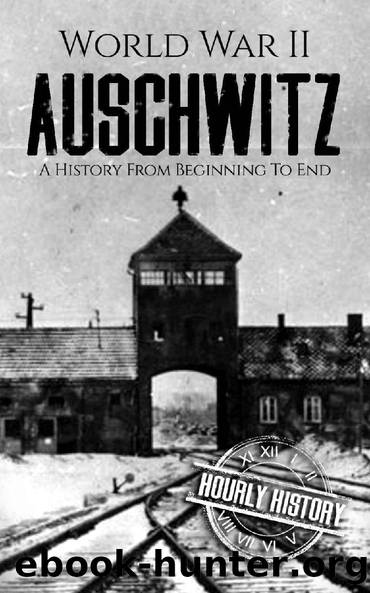World War II Auschwitz: A History From Beginning to End by Hourly History

Author:Hourly History [History, Hourly]
Language: eng
Format: epub
Publisher: Hourly History
Published: 2017-11-28T00:00:00+00:00
Chapter Five
The Angel of Death
âThere canât be two smart peoples in the world. Weâre going to win the war, so only the Aryan race will stand.â
âJosef Mengele
He was not the only physician assigned to Auschwitz. He wasnât even the highest-ranking physician in the camp. But it is Dr. Josef Mengele whose medical malevolence looms largest over the legacy of Auschwitz. Known as the Angel of Death or the White Angel, Mengele accompanied the 30 physicians who made their rounds in the camp, determining which arrivals could work and which would be sent immediately to the gas chambers. He was known for appearing fastidiously dressed in his Nazi uniform, even when he wasnât on duty, when the arrivals came to the camp so that he could take part in the process of deciding who would live and who would die.
Mengele, who was born in 1911, studied physical anthropology and medicine at the University of Munich, receiving a PhD. In 1937, he went to work at the Institute for Hereditary Biology and Racial Hygiene, joining Dr. Otmar von Verschuer, whose research focused on twins. That same year, Mengele joined the Nazi Party and the following year, the Schutzstaffel or SS. Drafted into the German army in 1940, he served in a medical capacity until he was wounded. Returning to Germany in 1943, he once again joined Dr. von Verschuer at the Kaiser Wilhelm Institute for Anthropology, Human Genetics and Eugenics.
In May of that year, Captain Mengele was transferred to Auschwitz. He made a memorable impression in the selection process as he determined which new arrivals would live and which would die. Survivors reported that to be sent to the left meant death; directed to the right was life. Usually, children under the age of 15 were sent to the chambers, but one 13-year-old girl, Ann Feng Fosenheck, was allowed to live; her mother, sister, and her sisterâs children were sent to their death by Mengele. âThey went straight into the gas chamber. I on the other hand was brought into a barrack.â
For Mengele, Auschwitz was a laboratory where there were no constraints and he was free to explore his research under any terms he chose. Twins were regarded as a means of studying the way in which heredity and environment affected a personâs health. When he was working at legitimate research facilities, Mengele had conducted authentic experiments with twins as test subjects. But at Auschwitz, he was able to experiment in a manner which allowed him free rein to conduct whatever sort of research, with whatever ramifications, he chose. In a camp occupied by Jewish and Romani test subjects, Mengeleâs murderous exploration into the fields of his interest was nothing short of barbarous. If a subject died as a result of his experiments, there were no repercussions. They were all under a death sentence anyway. He considered himself a scientist, keeping records and noting the height, weight, and comparisons of the twins as if he was legitimately researching themâbut science did not embrace pain with the zeal that Mengele displayed.
Download
This site does not store any files on its server. We only index and link to content provided by other sites. Please contact the content providers to delete copyright contents if any and email us, we'll remove relevant links or contents immediately.
| Africa | Americas |
| Arctic & Antarctica | Asia |
| Australia & Oceania | Europe |
| Middle East | Russia |
| United States | World |
| Ancient Civilizations | Military |
| Historical Study & Educational Resources |
The Light of Days by Judy Batalion(827)
Stalin's War: A New History of World War II by Sean McMeekin(687)
Walk in My Combat Boots by James Patterson(613)
The Pacific War 1941-1943 by James Holland(608)
Victory's Price (Star Wars) by Alexander Freed(576)
The Vietnam War: An Intimate History by Geoffrey C. Ward & Ken Burns(568)
First Platoon: A Story of Modern War in the Age of Identity Dominance by Annie Jacobsen(562)
Cold War (Alexander King Book 2) by Bradley Wright(557)
The American War in Afghanistan by Carter Malkasian(555)
Operation Pedestal by Max Hastings(538)
Blood and Ruins: The Great Imperial War, 1931-1945 by Richard Overy(530)
The Madman Theory by Jim Sciutto(521)
Concepts of Space by Jammer Max;(516)
Extreme Fitness by Chris McNab(514)
World War II Infantry Fire Support Tactics by Gordon L. Rottman(501)
Flying Tiger by Samson Jack(500)
Pathfinders by AL-KHALILI JIM(496)
Panzerkrieg by Mike Syron(488)
Hitler’s Pre-Emptive War: The Battle for Norway, 1940 by Henrik O. Lunde(484)
